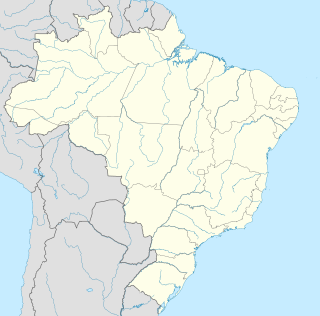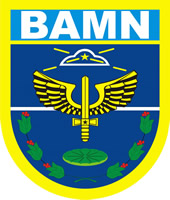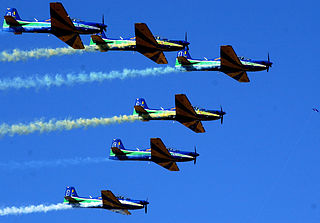 W
WThe Brazilian Air Force is the air branch of the Brazilian Armed Forces and one of the three national uniformed services. The FAB was formed when the Army and Navy air branch were merged into a single military force initially called "National Air Forces" in 1941. Both air branches transferred their equipment, installations and personnel to the new force.
 W
WThe Order of Aeronautical Merit is an award of the Brazilian Air Force, established on 1 November 1943 by President Getúlio Vargas. The order is presented in five grades and recognizes distinguished service and exceptional contributions to the Brazilian Air Force.
 W
WAfonsos Air Force Base – BAAF is a base of the Brazilian Air Force, located in Rio de Janeiro, Brazil. The official name of the Base is Campo Délio Jardim de Matos (1916–1990) after a former commander of the base and Minister of the Air Force.
 W
WThe Brazilian Air Force Academy is the Brazilian Air Force's educational institution that provides initial officer training for the main Officer Board of Brazil's Air Force Command. The Academy is located east of Pirassununga city, in São Paulo State county, and it is the largest Brazilian Air Base as well as the largest Air Force Academy of Latin America. All three Officer Formation Courses (CFOs) of Academia da Força Aérea are recognized as Superior Degree by Brazil's Ministry of Educations.
 W
WBrazilian Air Force One is the Brazilian Air Force call sign of the aircraft carrying the President of Brazil. On international flights the aircraft uses the Brazilian Air Force ICAO code BRS1 and callsign Brazilian Air Force 01. The Special Transport Group (GTE) is the unit of the Brazilian Air Force responsible for transporting the President, Vice-President and other senior government officials.
 W
WThe Brazilian Presidential Helicopter is the Brazilian Air Force helicopter used to transport the President of Brazil. The current aircraft designation is VH-36 Caracal.
 W
WCachimbo Airport is the military airport serving Campo de Provas Brigadeiro Velloso, a large Testing and Training complex of the Brazilian Armed Forces located in Serra do Cachimbo, in the southern part of the state of Pará, Brazil. It is operated by the Brazilian Air Force.
 W
WCanoas Air Force Base – BACO is a base of the Brazilian Air Force, located in Canoas, Brazil.
 W
WThe air traffic control centers of Brazil are known by the acronym CINDACTA, or "Centro Integrado de Defesa Aérea e Controle de Tráfego Aéreo. Four CINDACTAs are in operation, located in four cities and each responsible for different regions of Brazil's airspace.Cindacta I located in Brasília, near Pres. Juscelino Kubitschek International Airport: the square comprising Rio de Janeiro, São Paulo, Belo Horizonte and Brasília Cindacta II located in Curitiba, near Bacacheri Airport: Southern Region, Mato Grosso do Sul and the southern part of São Paulo Cindacta III located in Recife, near Recife/Guararapes-Gilberto Freyre International Airport: Northeast Region and the ocean between Brazil and Africa and Europe Cindacta IV located in Manaus, near Eduardo Gomes International Airport: Brazilian Amazon Region
 W
WThe Commander of the Brazilian Air Force is the head of the Brazilian Air Force and the leader of its Aeronautics Command. The Commander holds the rank of Tenente-Brigadeiro-do-Ar, is appointed by the President and reports directly to the Brazilian Minister of Defence. Prior to mid-1999 the Air Force was run by a military Minister of Aeronautics.
 W
WThe Brazilian Department of Science and Aerospace Technology is the national military research center for aviation and space flight. It is subordinated to the Brazilian Air Force (FAB).
 W
WFlorianópolis Air Force Base – BAFL is a base of the Brazilian Air Force, located in Florianópolis, Brazil.
 W
WGaleão Air Force Base – BAGL is a base of the Brazilian Air Force located in Rio de Janeiro, Brazil. It is named after Praia do Galeão, located in front of the original passenger terminal of the airport and presently the passenger terminal of the Brazilian Air Force. It was at this beach that in 1663 the galleon Padre Eterno was built.
 W
WThe Instituto Tecnológico de Aeronáutica is an institution of higher education maintained by the Brazilian Air Force and is located in São José dos Campos, Brazil. ITA is consistently ranked as one of the top engineering schools in Brazil and engages in advanced research in aerospace science and technology.
 W
WManaus Air Force Base – BAMN is a base of the Brazilian Air Force located in Manaus, Brazil. It was created in 1970 and between 1970 and 1976 public facilities of Ponta Pelada Airport were shared with the military facilities of Manaus Air Force Base. In 1976, with the opening of Eduardo Gomes International Airport, all public operations were transferred to the new airport. Ponta Pelada Airport was then renamed Manaus Air Force Base and since then it handles exclusively military operations.
 W
WNatal Air Force Base – BANT is a base of the Brazilian Air Force, located in Parnamirim, near Natal, Brazil.
 W
WPorto Velho Air Force Base – BAPV is a base of the Brazilian Air Force, located in Porto Velho, Brazil.
 W
WSanta Cruz Air Force Base – BASC is a base of the Brazilian Air Force located in Rio de Janeiro, Brazil.
 W
WSanta Maria Air Base – BASM is a base of the Brazilian Air Force, located in the city of Santa Maria, Brazil.
 W
WThe Aerial Demonstration Squadron, popularly known as Smoke Squadron is the Brazilian Air Force's air demonstration squadron. Its first display was on 14 May 1952 over Copacabana beach, using the North American T-6 Texan. The team used the T-6 from its formation until 1968, when it switched to the French Aérospatiale (Fouga) CM.170-2 Super Magister jet, called T-24 in FAB service. However, this model proved unsuitable to Brazilian conditions and, in 1972, the squadron reverted to the T-6, which was used until 1977.
 W
WThe South American air forces performs several joint aerial combat training exercises. Among the more important are Cruzex which is hosted by the Brazilian Air Force, Salitre hosted by the Chilean Air Force and Ceibo hosted by the Argentine Air Force. The goal is to train together in order to respond to a crisis or integrate into United Nations peacekeeping operations as a unified team; the United States Air Force and the Royal Canadian Air Force have also participated in some of these exercises in recent years.